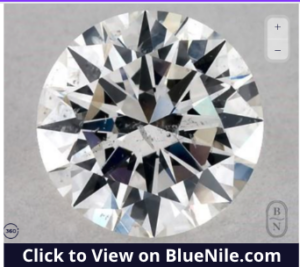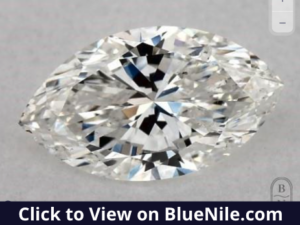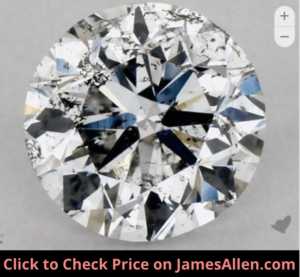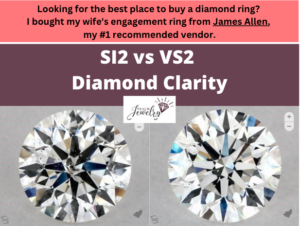
SI (slightly included) and VS (very slightly included) are two categories on the GIA diamond clarity scale. Each is broken down into two grades: SI1, SI2, VS1, and VS2.
The main difference between SI2 and VS2 diamonds is the extent to which inclusions affect their appearance, durability, and brilliance. SI2 diamonds have more impactful blemishes often visible without magnification. VS2 diamonds have minor flaws that generally aren’t noticeable to the naked eye.
For example, here’s a VS2 diamond from the vendor where I bought my wife’s engagement ring.
Compare it to this SI2 diamond, and you’ll immediately notice the distinction.
Let’s compare SI2 versus VS2 diamond clarity, including an overview of each, ways they’re different, and how to decide between them.
What are SI2 Diamonds?
SI2 diamonds earn that clarity grade because inclusions are easily visible with a jewelers loupe and often don’t require magnification to identify.
The grade is one above I1 and below SI1. It’s on the low end of the clarity scale.
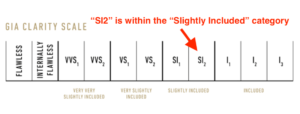
When the gemologist scans the diamond, they’ll find a variety of inclusions on its table and pavilion. These range from indented naturals and needles to black spots and twinning wisps.
For example, this SI2 diamond was graded by the Gemological Institute of America (GIA).
The report notes the following inclusions:
- Twinning wisps
- Clouds
- Feathers
- Needles
- Indented naturals
- Naturals
Many of these inclusions are dark, as opposed to transparent clouds and small pinpoints.
But the SI2 grade isn’t given to a diamond because of a specific number or type of inclusion. Instead, it refers to the overall impact it has on its quality.
So it could have a single type of inclusion in multiple places inside its facets, or it might contain several instances of small ones scattered across the table.
Many jewelry vendors won’t sell diamonds with a clarity grade lower than SI2. For example, Blue Nile’s selection doesn’t feature any I1, I2, or I3 loose diamonds.
On the other hand, James Allen, where I bought my wife’s ring, goes one step below SI2 and offers I1 clarity diamonds.
But SI2 is often the lowest clarity grade buyers choose for engagement rings because of the visibility of its imperfections. But my recommendation is to start your search at SI1.
What are VS2 Diamonds?
VS2 diamonds have inclusions easily visible at 10x magnification but often aren’t noticeable to the naked eye. The designation is one level above SI1 and below VS1.
When a gemologist examines a VS2 diamond, they’ll find flaws in multiple positions, but they likely aren’t covering too much of the table and pavilion.
There may be a few needles in one area and a black spots in another.
White twinning wisps or transparent feathers could form on the table, but you’ll often need a jeweler’s loupe to assess them.
This one-carat round cut diamond from James Allen earned a VS2 clarity grade from the GIA.
The gemologist identified crystals, clouds, and pinpoints.
I’ve posted the GIA grading report below so you can identify them on the clarity characteristics plot.
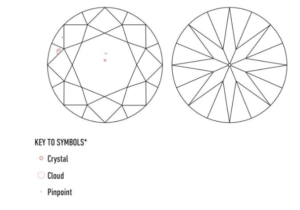
These are some of the same inclusions found in the SI2 diamond above.
The reason this one received a higher clarity is because those inclusions are smaller and have minimal impact on its brilliance, durability, and appearance.
They’re even difficult to identify on the plot, though two are located in the middle of the table.
It’s a subjective judgment by the organization creating the report, which is why it’s important to choose a reliable one.
Many buyers searching for an engagement ring choose VS2 diamonds as a starting point. I considered a few VS2 diamonds when I was searching for one to propose with, but I landed one step higher at VS1 clarity.
Either way, you don’t pay the premium charged for ones with higher clarity grades, and you avoid visible inclusions.
The inclusions in a VS2 diamond also have a minuscule effect on brilliance.
Although blemishes have the potential to distort the way light is reflected from the diamond’s facets, cut is a more important determinant of its sparkle.
If you choose a VS2 diamond with an excellent or ideal cut, its shine will match a flawless one.
How are SI2 and VS2 Diamonds Different?
1. SI2 Diamonds Often Have a Higher Number of Inclusions
Gemologists don’t determine a diamond’s clarity grade by counting the total number of inclusions.
If that were the case, one with several black spots and small needles could earn a lower grade than a diamond with two or three large, visible twinning wisps.
But in general, SI2 diamonds have a higher number of inclusions than ones graded VS2.
As an example, view this SI2 marquise cut diamond in close detail.
It has the following flaws:
- Feathers
- Twinning wisps
- Clouds
- Crystals
- Cavities
- Knots
- Indented naturals
- Naturals
The GIA report shows them located from a top-down and bottom-up view. Some are in the center of the table where they’re most visible.
But if you explore several VS2 diamonds, you might find an example with only two types of inclusions: feathers and indented naturals.
It’s clear the VS2 diamond is higher quality because there are far fewer flaws.
But there are exceptions to this rule.
Some VS2 clarity diamonds have more types of inclusions than the SI2 diamond above.
The reason they might receive the higher grade is because the inclusions are smaller and less impactful.
If you view the GIA report on the vendor’s website, you’ll find on the clarity characteristics plot they’re barely visible.
2. VS2 Diamonds are More Expensive
VS2 diamonds are more expensive than SI2 because buyers are willing to pay a higher price for a diamond with fewer imperfections.
This idea is true across the four Cs of color, cut, clarity, and carat, where the price increases as you move up the scales.
The best way to compare VS2 versus SI2 diamond prices is to examine costs for a diamond with all the same qualities, except different clarity grades.
I assessed prices for more than 75 diamonds from James Allen with the following traits:
- Carat weight: 0.90
- Cut: Very good
- Color: F
For ones with a SI2 grade, the average price was $3,751. The range was $2,910-$4,630.
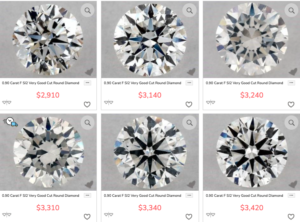
The VS2 diamonds cost an average of $5,747, with a range of $4,980-$7,280.
That’s a 53 percent premium for VS2 diamonds over SI2. In fact, the least expensive VS2 diamond in their inventory cost more than the most expensive SI2 diamond.
This further demonstrates the significant difference in prices between the two.
Prices continue to increase along the clarity scale, whether you choose a VVS1, VVS2, or flawless diamond.
By choosing a diamond with a lower clarity grade, you can select one with higher qualities in other areas without raising the total price.
3. Inclusions in SI2 Diamonds are More Visible
Most buyers aren’t primarily concerned about the way inclusions impact the structure of a stone or its brilliance. The important factor is how imperfections affects its visible appearance to the naked eye.
An engagement ring appears lackluster if the center diamond has noticeable flaws. Even a single black spot on its table can diminish its quality.
That’s why I recommend prioritizing eye-cleanliness instead of a specific clarity grade like SI2 or VS2.
But SI2 diamonds are more likely to have visible inclusions, especially if it’s larger than one carat.
For example, this one-carat SI2 diamond is full of inclusions that are easy to identify in a high-resolution photo.
I suspect that’s apparent when viewed in a normal setting.
But this diamond also earned an SI2 grade.
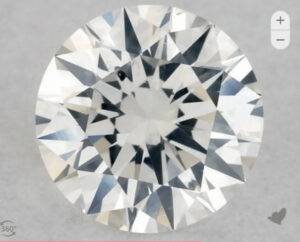
The inclusions aren’t as visible in the photo.
The only one that stands out at certain angles is a black spot from carbon that never fully crystalized.
One reason is it’s only 0.80 carats. Another is the other inclusions appear to be transparent needles and small feathers.
VS2 diamonds, on the other hand, are often eye-clean if they weigh less than 1.5 carats. No matter the angle you rotate a VS2 diamond, you won’t identify visible inclusions.
So it could be the right pick for an engagement ring diamond.
4. VS2 Diamonds Have Stronger Durability
VS2 diamonds have a lower chance of chipping because inclusions affect durability. The exact impact depends on factors such as:
- The type of inclusion
- Position
- The size of the flaw
If a diamond has a large inclusion in a vulnerable area like an extremely thin girdle or sharp corner, it’s more likely to fracture with hard impact or a drop.
For example, check out this GIA report for an SI2 princess cut diamond.
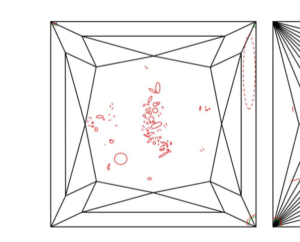
There’s an indented natural on the top-down view in the lower right and cavities in the upper left corner. While their position isn’t as impactful on its appearance, they might pose risks to its durability.
Concerns about your SI2 diamond chipping shouldn’t be top of mind, but take practical steps to prevent this problem.
Avoid inclusions such as diamond cavities in weak positions or large feathers near the girdle.
Not only do they diminish its visible appearance, it leaves the gem susceptible to breaking.
Instead, consider an SI2 diamond with several small inclusions in durable areas. This minimizes the risk of chipping, which is a difficult issue to repair.
Overall, I recommend choosing a strong setting that protects vulnerable areas like corners, whether you choose a VS1, VVS1, VS2 or SI2 diamond.
How to Decide Between SI2 and VS2 Diamonds
Deciding between SI2 versus VS2 diamonds involves understanding how inclusions affect their overall value and performance.
There’s more to consider than its appearance to the naked eye, but that should be top of mind.
Here are some guidelines.
Consider an SI2 diamond if:
- You have the chance to view it in-person or through high-resolution images to learn how its inclusions may appear
- You’re looking to put the savings into other qualities about the diamond ring, such as its carat weight or cut grade
- You’ll protect any vulnerable areas with a strong setting or avoid one with large inclusions in weak spots
A VS2 diamond might be right for you if:
- You want to avoid the premiums charged for higher clarity grades but want one that’s eye-clean
- You aren’t concerned about the presence of several types of inclusions scattered across its table, as long as they aren’t visible
Explore diamonds with different clarity grades at in-person and online diamond retailers.
By pairing VS2 and SI2 diamonds with different types of settings, you’ll find a ring that’s right for you.
Clarity: SI2 versus VS2 Diamonds – A Q&A Exploration
Q1: What are the key distinctions between SI2 and VS2 diamond clarity grades?
A1: SI2 grade diamonds have noticeable inclusions that are often visible to the naked eye, whereas VS2 diamonds have minor inclusions that are less visible without magnification.
Q2: How do inclusions in SI2 and VS2 diamonds affect their appearance and overall quality?
A2: Inclusions in SI2 diamonds may affect the diamond’s brilliance and overall appearance, while inclusions in VS2 diamonds are often less noticeable and have a lesser impact on appearance.
Q3: How does the grading process account for different types of inclusions in SI2 and VS2 diamonds?
A3: The grading process evaluates the size, number, position, and nature of inclusions to determine the clarity grade, with SI2 diamonds having more or larger inclusions compared to VS2 diamonds.
Q4: What are the implications of choosing an SI2 versus a VS2 diamond for engagement rings?
A4: Choosing an SI2 diamond may be more budget-friendly but may come with visible inclusions, while a VS2 diamond, being of higher clarity, will have fewer visible inclusions, enhancing the ring’s overall appearance.
Q5: How do the price points of SI2 and VS2 diamonds compare?
A5: VS2 diamonds are generally priced higher due to their better clarity grade compared to SI2 diamonds which are more affordable.
Q6: Are there specific diamond shapes where the clarity grade might be more critical between SI2 and VS2?
A6: Yes, in shapes like Emerald or Asscher, the clarity grade is more critical as these shapes tend to expose inclusions more than others.
Q7: How do the positions of inclusions impact the clarity grading of SI2 and VS2 diamonds?
A7: The position of inclusions can significantly impact the clarity grading. Inclusions near the center or those that are spread out can lower the clarity grade as they are more visible compared to inclusions near the edges.
Q8: What considerations should buyers have regarding the maintenance and durability of SI2 and VS2 diamonds?
A8: SI2 diamonds with surface-reaching inclusions may be less durable. Buyers should consider professional cleaning and regular check-ups to ensure the longevity and brilliance of both SI2 and VS2 diamonds.
Q9: How does the visibility of inclusions in SI2 and VS2 diamonds compare under different lighting conditions?
A9: Inclusions in SI2 diamonds may be more visible under bright lighting conditions, whereas inclusions in VS2 diamonds are harder to detect without magnification, regardless of the lighting conditions.
Q10: Are there any notable market preferences for SI2 or VS2 diamonds, and what factors drive these preferences?
A10: Market preferences may lean towards VS2 diamonds due to their higher clarity, but budget-conscious buyers might opt for SI2 diamonds. The factors driving these preferences include budget, personal aesthetic preferences, and the importance placed on diamond clarity.

Jacob Clarke
Jacob Clarke is the founder of TeachJewelry.com.
He earned an Applied Jewelry Professional Diploma from the Gemological Institute of America (GIA) and now brings you essential information about diamonds, settings, and more.
Jacob has consulted with leading jewelry brands, and his work has been cited in Clean Origin, Diamond Nexus and industry publications.
He's also a member of the International Gem Society.
He enjoys discussing jewelry with readers, so contact him with any questions at jacob.clarke@teachjewelry.com.

